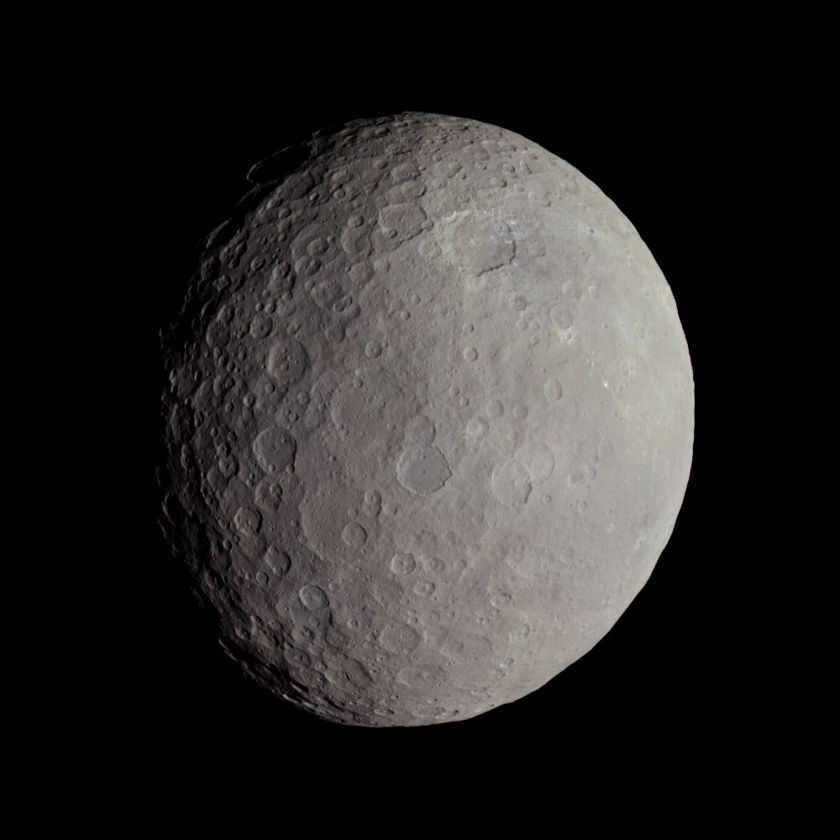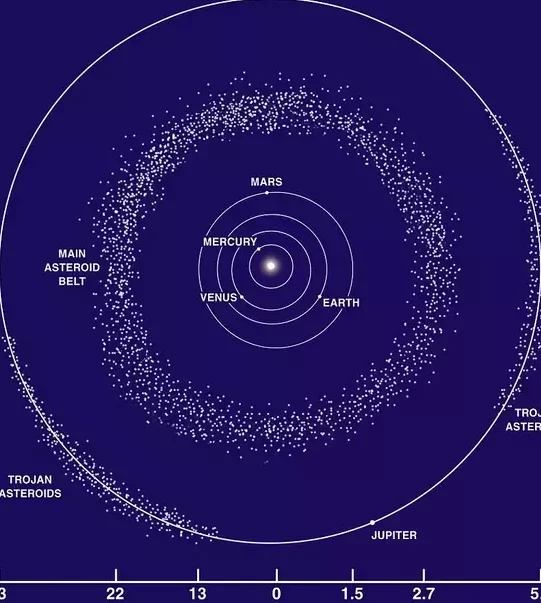- The Asteroid Belt is a region in the Solar System that lies between the orbits of Mars and Jupiter. It is where a multitude of objects, known as asteroids or minor planets, gather. These objects come in various sizes and shapes, mostly irregular.
This area is also commonly known as the main asteroid belt or simply the main belt. It is distinguished from other similar clusters of small planets, such as the Kuiper belt located beyond Neptune’s orbit, as well as the scattered disk and Oort cloud clusters.
The term “asteroid belt” gained popularity in the early 1850s. It was first used by Alexander von Humboldt in his book “Kosmos – Entwurf einer physischen Weltbeschreibung”.
About 4% of the Moon’s mass is accounted for by the total mass of the main belt, with more than half of it being concentrated in four prominent objects: Ceres, Vesta, Pallada, and Hygeia. These four objects have an average diameter of over 400 km, and the largest among them, Ceres, is the only dwarf planet in the main belt, boasting a diameter exceeding 950 km. In fact, the mass of Ceres is twice the combined mass of Pallada and Vesta. However, the majority of asteroids in the main belt, which number in the millions, are considerably smaller, ranging from a few tens of meters in size. Despite their abundance, asteroids are spread out so widely in this region of space that no spacecraft passing through this area has ever suffered any damage from them.
The asteroid belt consists of a unique formation that originated near Jupiter. The gravitational influence of Jupiter constantly disrupted the orbits of planetesimals, leading to the current composition of the belt. Jupiter’s gravitational pull provided excess orbital energy, resulting in more intense collisions between these bodies. This prevented them from merging into a protoplanet and growing larger.
As a consequence, the majority of planetesimals fragmented into numerous smaller pieces. Many of these fragments were either ejected from the solar system, which explains the low density of the asteroid belt, or moved into elongated orbits. Along these orbits, they occasionally entered the inner region of the solar system and collided with the terrestrial planets, a phenomenon known as late heavy bombardment.
After this time, there were also collisions between asteroids, resulting in the formation of numerous asteroid families. These families consist of groups of bodies that have similar orbits and chemical compositions. Today, there are a significant number of asteroids that belong to these families, as well as the fine cosmic dust that creates the zodiacal light.
Furthermore, the gravity of Jupiter also leads to the creation of regions with unstable orbits. These regions are virtually devoid of asteroids due to their resonance with Jupiter. If an asteroid enters one of these regions, it will either be ejected from the solar system relatively quickly or it will join the population of asteroids that cross the orbits of the inner planets. Currently, there are very few asteroids in these regions, but the orbits of many small asteroids continue to slowly change due to other factors.
An asteroid, previously known as a small planet, is a relatively small celestial body that orbits the Sun in the solar system. Unlike planets, asteroids are much smaller in size and mass, and they have an irregular shape and lack an atmosphere. However, some asteroids may have satellites.
The spectral class of an asteroid is a characteristic that helps classify them. Each asteroid is assigned to a specific class based on its spectral signature, color, and sometimes albedo. These classes are believed to be indicative of the asteroid’s chemical composition on its surface. In smaller asteroids, which are not internally differentiated, the surface and internal composition are assumed to be uniform. However, larger asteroids like Ceres and Vesta have a known internal structure.
Near-Earth Asteroids (NEOs) are celestial bodies that have perihelion distances equal to or less than 1.3 astronomical units (a.u.). Those among them that may come within a distance of 0.05 astronomical units (a.e.) or less from Earth in the foreseeable future, and have an absolute stellar magnitude brighter than 22m, are classified as potentially hazardous objects.
Cupids are a collection of near-Earth asteroids whose orbits lie entirely outside the Earth’s orbital path (their distance from the Sun at perihelion is greater than the Earth’s aphelion distance, but less than 1.3 a.e.). Specifically, their perihelion distance is 1.017 a.e. to 1 a.e. Although their orbits generally lie beyond the Earth’s path, they still intersect it in the Earth’s aphelion region. This group of asteroids was named after its first discovered member, as per tradition.
References in the literary works
At the same time, Observer was rapidly gaining knowledge about the structure of the local planetary system through careful observations. The four planets closest to the star were smaller in size but had a higher density compared to the four more distant planets. Spectral analysis of the distant planets revealed that they were predominantly composed of light gases, but their immense size made them significantly more massive than the closer planets. By conducting a detailed spectral analysis of the star itself, named HZW-1020-3964-2904-3845 (QSL), Observer discovered the presence of not only hydrogen and helium nuclei but also heavier elements like carbon. Based on the ratio of these elements, Observer estimated that the star was approximately 7 billion years old. This newfound knowledge provided insight into how the star and its planetary system originated billions of years ago and what the future might hold for them. These observations allowed Observer to definitively classify the star-planet system according to the detailed descriptions in the catalog. Observer had the entire star catalog of the Milky Way stored in memory and quickly located the relevant section. According to the catalog, it was common for star-planet systems to have asteroid belts consisting of matter that failed to form into planets. Observer then shifted focus from the planets to the space between them and, through the telescope, discovered a wide belt of asteroids located between the fourth and fifth planets. Orbital modeling confirmed the presence of these asteroids. With the plan of action now established, Observer was ready to proceed!
Nowadays, the Main Asteroid Belt is viewed as a remnant from the time when planets were being formed. It is located between 2.5 and 3.7 astronomical units (a.u.) and is made up of various large spheroidal bodies such as Ceres, Pallada, Juno, Vesta, and others. Additionally, there are numerous smaller rocky bodies, some of which are fragmented. This belt is situated at the boundary between the Earth-like planets and Jupiter, often referred to as a “failed planet”. Only a small fraction of the original solid matter remains in this region. Furthermore, there is an observed gradient in composition among the asteroids known as the type “asteroids”.
Despite the many advantages of the “Nice model” in explaining numerous properties of the solar system, there are certain aspects that raise questions. One of the main concerns is the orbital resonances between Jupiter and Mars during Jupiter’s migration. While these resonances are not as dangerous as the 1:7 resonance, they should still cause elongation of Mars’ orbit and its entry into the asteroid belt. However, such phenomena are not observed in our solar system. Another flaw in the model is related to the fate of irregular satellites. The model successfully predicts the capture of planetesimals into the orbits of irregular satellites of Saturn, Uranus, and Neptune, but it fails to explain the arrangement of Jupiter’s irregular satellites. According to the model, these satellites should have a similar origin, through the capture of planetesimals during close encounters between the two giant planets. However, the classical “Nice model” does not account for any close encounters between Jupiter and other planets. In some modeling runs, there were close passes of Uranus or Neptune past Jupiter, resulting in a sudden change in Jupiter’s orbit and the avoidance of a dangerous resonance with Mars. In these cases, the ice giant (either Uranus or Neptune) either moved to a more distant orbit from the Sun or was completely ejected from the system. Subsequent studies by the authors of the “Nice model” have shown that this “jumping Jupiter” scenario better aligns with the actual structure of asteroid orbits than the smooth change of orbits in the original model (Morbidelli et al., 2010). Furthermore, it is also possible for an ice giant to be ejected from the Solar System altogether, and it is conceivable that this ejected planet originally contained another ice giant similar to Uranus and Neptune. Astronomers have indeed discovered such ejected planets floating freely in interstellar space in recent years.
An interesting finding comes from astronomer Alessandro Morbidelli of the Observatoire de la Côte d’Azur in Nice. His computer model suggests that the majority of Earth’s water reserves were acquired through the impacts of protoplanets originating from the outer region of the asteroid belt. These protoplanets collided with Earth during its final stages of formation. According to Morbidelli, comets only contributed a maximum of 10% of the water, with the remainder being delivered by smaller planets that collided with Earth.
Additional concepts (continuation)
Jupiter, the largest planet in our solar system, is the fifth planet from the Sun. It is categorized as a gas giant, along with Saturn, Uranus, and Neptune.
An astronomer, also known as an astronomist in professional terms, is a scientist who specializes in the study of astronomy.
Trojan asteroids refer to a group of asteroids located near the Lagrangian points L4 and L5, which are in a 1:1 orbital resonance with any planet.
The Jupiter Trojan Asteroids consist of two major groups of asteroids that orbit the Sun in close proximity to Jupiter’s Lagrange points L4 and L5, in a 1:1 orbital resonance. These asteroids are named after characters from the Trojan War, as described in the epic poem Iliad.
The Minor Planet Center (MPC) is situated at the Smithsonian Astrophysical Observatory (SAO), a division of the Harvard-Smithsonian Center for Astrophysics (CfA) in collaboration with Harvard University Observatory (HCO).
A minor planet is a small celestial body that orbits the Sun and is distinct from the larger planets.
Asteroid occultation is an astronomical event where a light source, typically a star, is blocked by an asteroid as it moves across the sky. These events occur frequently around the globe. On an average night, anywhere on Earth may witness one occultation of a star with a magnitude brighter than 13, by an asteroid that has already been cataloged.
Kirkwood gaps refer to specific regions within the asteroid belt that are formed due to the gravitational influence of Jupiter. These areas have a scarcity of asteroids.
Mars is the seventh largest planet in the Solar System and is located fourth farthest from the Sun. It has a mass that is 10.7% of Earth’s mass. The planet is named after Mars, the ancient Roman god of war, who is equivalent to the ancient Greek god Ares. Mars is often referred to as the “red planet” due to its reddish surface color, which is caused by the presence of the mineral maghemite, a γ-oxide of iron(III).
Centaurs are a group of asteroids that can be found between the orbits of Jupiter and Neptune. They have properties that are in between those of main belt asteroids and Kuiper belt objects, and they also share some similarities with comets. Centaurs have orbits that are sometimes highly elongated and unstable because they cross the paths of one or more giant planets. As a result, the lifespan of centaurs is relatively short, lasting only a few million years, as the gravitational pull of the large planets causes them to be pushed out of their orbits.
A light curve is a function that shows how the brightness of an astronomical object changes over time. This concept applies to both self-luminous objects like stars and objects that reflect the light of a nearby source, such as the Sun or another star. Examples of such objects include planets, their moons, asteroids, and more.
In celestial mechanics, orbital resonance refers to a situation where the periods of revolution of two or more celestial bodies are related by small whole numbers. This means that these bodies periodically come close to each other at certain points in their orbits. The resulting regular changes in the gravitational interaction between these bodies can help stabilize their orbits.
The rotation period of a space object is the time it takes for the object to complete one full rotation around its axis relative to the stars.
The region of the Solar System extending from the orbit of Neptune (30 a.u. from the Sun) to approximately 55 a.u. from the Sun is known as the Kuiper Belt, also referred to as the Edgeworth-Kuiper Belt. While resembling the asteroid belt, the Kuiper Belt is significantly wider, measuring about 20 times the width, and is also 20 to 200 times more massive. Like the asteroid belt, it primarily consists of small celestial bodies that are remnants from the early formation of the solar system. However, unlike the objects found in the asteroid belt, those within the Kuiper Belt are primarily composed of rocks and metals.
Atoms are a collection of asteroids that orbit near-Earth and intersect the Earth’s orbit from the inner side. These asteroids have a greater distance from the Sun at aphelion compared to the Earth’s perihelion distance (Q > 0.983 a.e.), but their major semi-axis is smaller than the Earth’s. For more information, check out the List of asteroids crossing the Earth’s orbit.
This list categorizes different small bodies in the Solar System into groups and classes based on their orbital and physical parameters. Typically, these groups are named after their first discovered or largest representative, which is often the same body, or based on the orbital location of the group’s representatives in relation to the planets.
Observation arc refers to the duration between the initial and latest observations that track the trajectory of an object. Typically, the observation arc is measured in days or years. This term is commonly used in the context of detecting and monitoring asteroids and comets.
Neptune trojan asteroids, also known as Neptune trojans, are a collection of Kuiper belt asteroids that orbit the Sun at a 60° angle to Neptune. They exist in either point L4 or point L5, which are the two Lagrangian points in Neptune’s orbit.
Stellar magnitude (luminosity) is an attribute that quantifies the brightness of an object, represented by the symbol m (derived from the Latin word magnitudo “magnitude, size”). This concept is commonly used to describe celestial bodies. Stellar magnitude indicates the energy flux emitted by the celestial body in question (i.e., the energy of all photons per second) per unit area. Therefore, the apparent stellar magnitude is influenced by both the intrinsic characteristics of the object (i.e., luminosity) and its distance from the observer. The smaller the stellar magnitude value, the fainter the object appears.
Mercury, the closest planet to the Sun in the Solar System, is the tiniest member of the Earth group of planets. It was named after the ancient Roman god of commerce and is known for its swift movement across the celestial sphere compared to other planets.
Neptune is the farthest planet from Earth in the Solar System, and it is the eighth planet in the order of distance. In terms of size, it is the fourth largest planet by diameter and the third largest by mass. Its mass is 17.2 times that of Earth, and its equatorial diameter is 3.9 times larger than Earth’s.
A quasi-sputnik, which gets its name from the Latin word “quas(i)” meaning “like” or “something like,” is an object that is in a 1:1 orbital resonance with a planet. This type of resonance allows the object to maintain a close proximity to the planet for multiple orbital periods.
Main Belt Comets are celestial objects that orbit the Sun within the main asteroid belt. These comets exhibit cometary activity during a specific portion of their orbit.
Amateur stargazing is a kind of pastime that entails observing, capturing, or researching celestial objects and occurrences.
An unconventional moon is a natural satellite of a planet whose movement deviates from the standard principles. It could be a moon with a more elongated orbit, meaning it has a higher eccentricity, a moon that orbits in the opposite direction, or a moon with a greater inclination to the equatorial plane.
The Julian year (symbol: a) is a measurement of time. A Julian year is equivalent to 365.25 Julian days, which is equal to 31,557,600 seconds. This is the average duration of a year in the Julian calendar, which was used in Europe during ancient times and the Middle Ages. Julian years are utilized in astronomy to indicate the time it takes for celestial objects (such as asteroids and comets) to complete one revolution around the Sun. They are also used in geochronology to measure significant time periods, as well as in nuclear science.
Eryda (136199 Eris in the CMP catalog) is the second largest dwarf planet in the Solar System after Pluto, and it is also the most massive and farthest from the Sun. Previously known as Xena, Eryda belongs to a group of trans-Neptunian objects called plutoids. It used to be considered as the tenth planet until the XXVI Assembly of the International Astronomical Union, when Eryda, along with Pluto, was reclassified.
Saturn, the sixth planet from the Sun, is the second largest planet in the Solar System, after Jupiter. Saturn, along with Jupiter, Uranus, and Neptune, is classified as a gas giant. The name Saturn is derived from the Roman god of agriculture, and its symbol is depicted as a sickle (Unicode: ♄).
The Oort Cloud is an imagined spherical area of the Solar System that acts as a source of long-period comets. The presence of the Oort cloud has not been directly confirmed, but several indirect pieces of evidence suggest its existence.
A dispersed disk is a distant part of the solar system with a low population of small objects, primarily made up of ice. These objects are known as scattered disk objects (SDO*, scattered disk objects); they are a subgroup of the extensive family of trans-Neptunian objects (TNOs). The inner section of the dispersed disk partly overlaps with the Kuiper belt, but in comparison, the outer boundary of the disk is much farther from the Sun and has a significantly different inclination to the ecliptic plane.
Continuation of References in the Literature
Fortunately, in the past billion years, the asteroid belt has achieved a state of relative equilibrium, with asteroids moving along stable and known orbits. This means that the likelihood of Earth colliding with another massive piece of debris is not very high. Currently, it is estimated that there are around 1,500 asteroids near Earth, ranging in size from a few hundred meters to several kilometers in diameter. Astronomers and mathematicians have calculated that the chance of Earth colliding with one of these asteroids, with a diameter of about a kilometer, is one in five thousand over the next century. Is this a significant risk or a minor one? To put it in perspective, major space accidents have a probability of one in three thousand. However, it’s important to remember that these are just probabilities. Recently, astronomers observed an asteroid with a diameter of several hundred meters passing close to the Moon’s orbit. These close encounters are already very dangerous. If such an asteroid were to impact Earth, it would create a crater tens of kilometers in size, and if it landed in the ocean, it would generate a powerful tsunami.
“In the orbit of Jupiter, there is a cluster of red celestial bodies located 60 degrees ahead of it. These celestial bodies are commonly referred to as the Greeks. In contrast, the Trojans are situated 60 degrees behind Jupiter. This means that astronomers have collectively assigned the names of heroes from the Trojan War, which occurred over three and a half thousand years ago, to numerous objects in this particular region of the asteroid belt. Additionally, at the Pulkovo Observatory, we have been studying another intriguing group of asteroids known as the Gilda family, in which I have actively participated. This particular class of asteroids poses a significant threat as they can be propelled towards the Earth due to the gravitational forces of the Sun and Jupiter. A few years ago, shortly before their encounter with Earth, we were able to capture several dozen images using the matrix of our Pulkovo telescope. Our observations, combined with those conducted by other nations, have played a crucial role in determining the exact trajectory of their impact.”
The concept of the Asteroid Belt has a second interpretation, suggesting the existence of a former planet between Mars and Jupiter, commonly referred to as Phaeton in Greek mythology. Another name for this hypothetical planet is Planet Olbers, named after the scientist who made significant discoveries within the Asteroid Belt, including Ceres, Vesta, Pallada, and Hygeia. Initially, these objects were mistaken as full-fledged planets. According to this theory, it is believed that Phaeton met its demise due to the gravitational influence of Jupiter, resulting in the formation of the Asteroid Belt. This theory is supported by the fact that the Belt possesses its own distinct orbit and is positioned precisely where the hypothetical planet should be, as indicated by the Titius-Bode system, which postulates a geometric progression in the arrangement of planets. Remarkably, the entire Solar System aligns with this system, with the exception of the Asteroid Belt.
Once upon a time, a massive piece weighing multiple tons broke away from the rest. Its path was influenced by the gravitational fields of the planets it encountered along the way. Celestial objects from the asteroid belt positioned between the orbits of Jupiter and Mars collided with the colossal fragment, resulting in its fragmentation into smaller pieces. Consequently, after a twenty million year voyage, the fragment arrived at a small planet with a weight no greater than half a ton. As it made its way towards a new obstacle, it entered the Earth’s atmosphere and disintegrated into multiple fragments. As it neared the Earth’s surface, its velocity decreased, and for the final stretch of its journey, it traveled in an almost vertical trajectory.
The Solar System is made up of 9 planets – Mercury, Venus (which are considered inner planets), Earth and its natural satellite Moon, Mars, Jupiter, Saturn, Uranus, Neptune, and Pluto (excluding Earth, these are known as the outer planets). These planets are arranged in order of their distance from the Sun, which exerts its gravitational force to control their movements. They all orbit the Sun in elliptical paths that are relatively aligned with each other. Between Mars and Jupiter, there is a belt of asteroids, numbering in the millions, including both large and small ones.
According to the German astronomer G. Olbers, the asteroid belt was formed from the remains of the destroyed planet Phaeton.
Figure 5a shows the orbits of the inner planets – Mercury, Venus, Earth, and Mars, as well as the asteroid belt and the orbit of Jupiter.
The area between Mars and Jupiter in the solar system is known as the main asteroid belt. This region is filled with a variety of objects, ranging in size and shape, commonly referred to as asteroids or minor planets. It is also called the main belt, distinguishing it from other small planet clusters like the Kuiper belt and the scattered disk objects found beyond Neptune’s orbit.
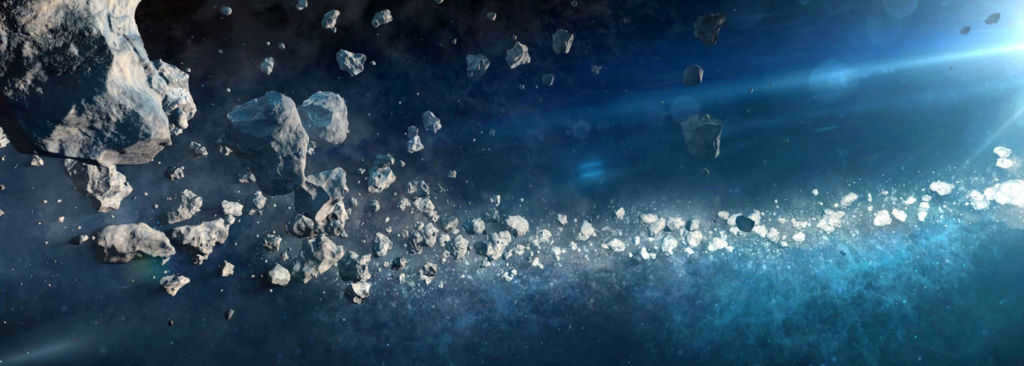

The primary asteroid belt
Astronomers first discovered the initial asteroids within the belt during the early 19th century. Presently, the scientific community recognizes the asteroid belt as one of the most expansive aggregations of celestial bodies situated in the solar system. These celestial bodies, often referred to as “minor planets,” span a range in size from a few hundred meters to several hundred kilometers. Approximately 300,000 of these massive rocky objects orbit independently within the solar system’s asteroid belt.
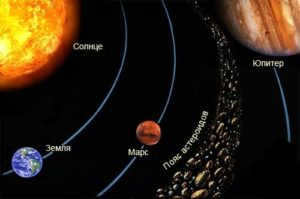
The biggest items in the asteroid belt
In the present day, any objects measuring a minimum of 1 km in size are classified as asteroids. Smaller objects are referred to as meteoroids. Alongside the asteroids in the Belt, there are approximately 20 minor planets (or sizable asteroids) and one dwarf planet, Ceres.
Ceres is classified as a dwarf planet
The diameter of Ceres is 950 km.
It is located at a distance of 413.9 million kilometers from the sun.
Similar to the planets in the Earth group, Ceres has undergone differentiation, resulting in a silicate core surrounded by an icy mantle and a thin carbon crust.
Vesta, on the other hand, is an asteroid
With a diameter of 525.4 km, Vesta is situated approximately 353.2 million kilometers away from the sun.
While it ranks first in terms of brightness, it takes the second spot in mass and is the third largest in size.
Pallada is a celestial body
It has a diameter of 512 km.
The distance from Pallada to the Sun is approximately 414.7 million kilometers.
Similar to Uranus, Pallada has a significant inclination of its axis of rotation, measuring 34 degrees, whereas the other three largest asteroids have an inclination angle that does not exceed 10 degrees.
Hygeia, one of the many asteroids in our solar system
With a diameter of 407.12 km, Hygeia is a significant presence in space. It is located at a distance of approximately 350 million kilometers from the Sun. As the largest carbonaceous asteroid, it makes up about 75% of all asteroids in our solar system. Its irregular shape adds to its unique characteristics.
Asteroids, such as Hygeia, are celestial bodies that typically have a diameter larger than 30 meters. Smaller ones are referred to as meteoroids or meteorites. While the main asteroid belt contains a multitude of asteroids, the number of large bodies is relatively small. For instance, there are only around 200 asteroids with a diameter of 100 kilometers or more. However, there are over a thousand asteroids with a radius greater than 15 km. The main asteroid belt consists of millions of asteroids with diameters ranging from tens to hundreds of meters.
As we entered the 21st century, astronomers have gained extensive knowledge about over 285 thousand small planets found within the Great Belt of asteroids. Additionally, a vast multitude of these asteroids range in size from 0.7 to 100 kilometers in diameter. It is no surprise that these celestial objects exist devoid of any atmosphere.
Juno is a celestial body in the form of an asteroid
The size of Juno is approximately 233.92 kilometers in diameter.
The distance of Juno from the sun is approximately 400 million kilometers.
Juno is recognized as the largest S-class asteroid, second only to Eunomia. In terms of mass, Juno’s weight is equivalent to 3% of Ceres, the largest object within the Asteroid Belt.
Antipope is classified as a binary asteroid
The diameter of Antipope measures about 87.8 km.
The distance of Antipope from the sun is approximately 467 million kilometers.
Antipope is classified as a binary asteroid within the main belt. The two components of this system orbit around a common center of mass, maintaining a distance of 171 km between them.
There is a clear correlation between the composition of asteroids and their proximity to the Sun. Typically, rocky asteroids composed of anhydrous silicates are found closer to the Sun compared to carbonaceous clay asteroids, which often contain traces of water, mostly in a bound state but possibly as regular water ice. Additionally, asteroids in close proximity to the Sun exhibit significantly higher albedos than those located in the central and outer regions. This phenomenon is believed to be attributed to the properties of the protoplanetary disk from which the asteroids originated. In the inner regions of the asteroid belt, solar radiation had a greater impact, causing the volatilization of lighter elements, including water, towards the outer regions. Consequently, water condensed on asteroids in the outer part of the belt while the inner regions, where asteroids experience greater heating, retained minimal amounts of water.
The author of this article is astroson.com, and it was published on April 19, 2017.
The solar system description provides details about not just the eight planets and Pluto, but also various other formations that encompass a vast array of celestial bodies. These formations encompass the Kuiper belt, the diffuse disk, the Oort cloud, and the asteroid belt. In this article, we will focus on the asteroid belt.
Definition
Definition is the act of stating or describing exactly what something is or what a word or phrase means.
Definition can be used in various contexts, including in academic writing, legal documents, and everyday conversations. It helps to clarify the meaning of a concept, object, or term, and provides a common understanding among people.
There are different types of definitions, such as descriptive definitions that aim to provide a detailed description of the characteristics of something, and stipulative definitions that assign a specific meaning to a term.
Definition plays an important role in communication, as it allows individuals to convey their thoughts and ideas effectively. It helps to avoid misunderstandings and ensures that everyone is on the same page.
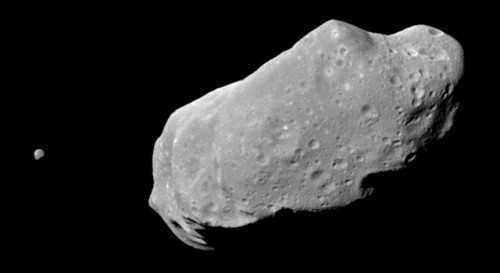
The composer Charles Burney provided the term “asteroid” to William Herschel, who adopted it. This word has its origins in Greek and translates to “like a star.” The reason behind using this term was the resemblance of asteroids to stars when observed through a telescope, as they appeared as dots compared to the disk-like appearance of planets.
Currently, there is no exact definition for this term. The primary defining characteristic of objects in the asteroid belt and similar formations is their size, with a minimum diameter of 50 meters. Space bodies smaller than this are considered meteors. On the other hand, the upper limit is the diameter of the dwarf planet Ceres, which is approximately 1000 km.
Where it is and what it offers
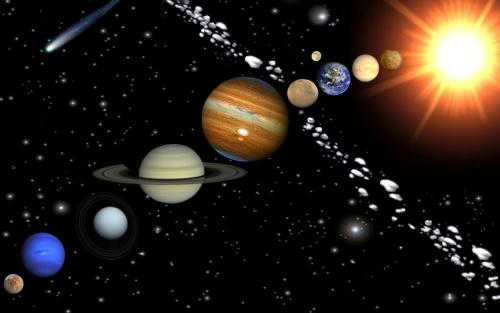
The region known as the asteroid belt is situated between the orbits of Mars and Jupiter. Presently, over 600 thousand objects have been identified within the belt, with more than 400,000 having their own designated number or even a unique name. Approximately 98% of these objects belong to the asteroid belt, positioned at a distance of 2.2 to 3.6 astronomical units from the Sun. The largest celestial body in this region is known as Ceres. At the International Astronomical Union (IAU) meeting in 2006, Ceres was awarded the status of a dwarf planet, alongside Pluto and several other entities. Following Ceres, the next most significant bodies in terms of size are Vesta, Pallada, and Hygeia, which together account for 51% of the entire mass of the asteroid belt.
Form
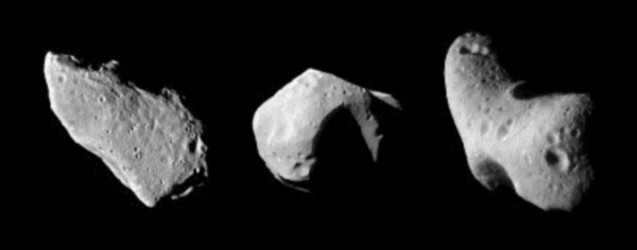
In addition to their size, the celestial bodies composing the asteroid belt possess several other fundamental attributes. They consist of rocky entities that revolve around the Sun. Extensive observations of these asteroids have concluded that they typically have irregular shapes and are in a state of rotation. These assumptions have been confirmed by images captured by spacecraft that have traversed the asteroid belt within our solar system. Scientists speculate that this peculiar shape is a consequence of the frequent collisions that occur between asteroids and other celestial objects.
Composition
At present, astronomers categorize asteroids into three distinct groups based on the primary substance that comprises their composition:
- Carbonaceous (class C);
- Silicate (class S) with a higher concentration of silicon;
- Metallic (class M).
Approximately 75% of all known asteroids fall into the carbonaceous category. However, this classification is met with skepticism among some scientists. They argue that the available data does not provide a clear indication of the dominant element found in the composition of asteroids in the asteroid belt.
In the year 2010, a fascinating revelation was made by a team of astronomers regarding the makeup of asteroids. Researchers detected the presence of water ice on Themis, a relatively sizable celestial body within this particular region. This discovery serves as an indirect affirmation of the theory that asteroids played a significant role as a source of water on an early Earth.
The average velocity at which objects in this region orbit the Sun is 20 km/s. Meanwhile, asteroids in the main asteroid belt take anywhere from three to nine Earth years to complete one revolution. Most of these asteroids have orbits that are slightly inclined, ranging from 5-10 degrees relative to the ecliptic plane. However, there are also objects that have a more significant inclination angle, up to 70 degrees, with the plane of Earth’s rotation around the Sun. This distinction forms the basis for classifying asteroids into two subsystems: flat and spherical. The orbits of asteroids in the flat subsystem have inclinations less than or equal to 8 degrees, while those in the spherical subsystem have inclinations greater than this value.
Origins
In the previous century, there was a widespread discussion in scientific circles about the hypothesis of the lost planet called Phaeton. It was believed that there could have been another planet’s orbit between Mars and Jupiter due to the significant distance between them. However, these ideas are now considered outdated. Present-day astronomers hold the view that a planet could not have formed in the region where the asteroid belt is located, and the main factor behind this is Jupiter.
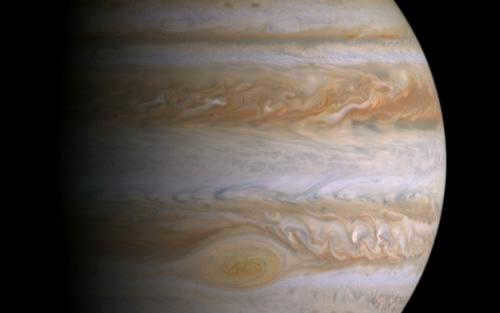
The formation of a gas giant in its early stages had a gravitational impact on the region near the Sun, causing it to attract some of the surrounding matter. However, any bodies that were not captured by Jupiter were dispersed in various directions, leading to an increase in the velocities of protoasteroids and a higher number of collisions. As a result, these bodies not only failed to grow in size and mass, but actually decreased. Consequently, the likelihood of a planet existing between Jupiter and Mars became nonexistent.
Continual Impact
Jupiter continues to exert a significant influence on the asteroid belt. Its immense gravitational force leads to alterations in the trajectories of certain celestial bodies. As a result, forbidden regions, with minimal asteroid presence, emerge under its sway. Whenever an object enters this zone due to a collision with another entity, it is promptly expelled. On occasion, the orbit is modified to such an extent that it entirely departs from the asteroid belt.
Additional formations of asteroids
In addition to the main asteroid belt, there are two other similar structures located on its outer edge. One of these formations can be found directly in Jupiter’s orbit and is made up of two groups of objects:
- The Greeks, which are positioned about 60 degrees ahead of the gas giant;
- The Trojans, which are located the same number of degrees behind.
One notable characteristic of these asteroids is their stable motion, which is made possible by their placement in the Lagrange points. These points provide a balanced gravitational influence on the objects, ensuring their stability.
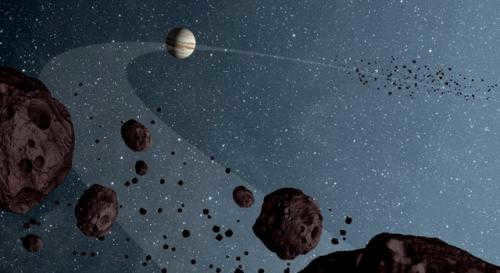
Despite being situated relatively close to Earth, the asteroid belt remains largely unexplored and harbors numerous enigmas. One of the foremost puzzles pertains to the genesis of the solar system’s minor celestial bodies. While existing theories on this matter may sound compelling, they have yet to be definitively substantiated.
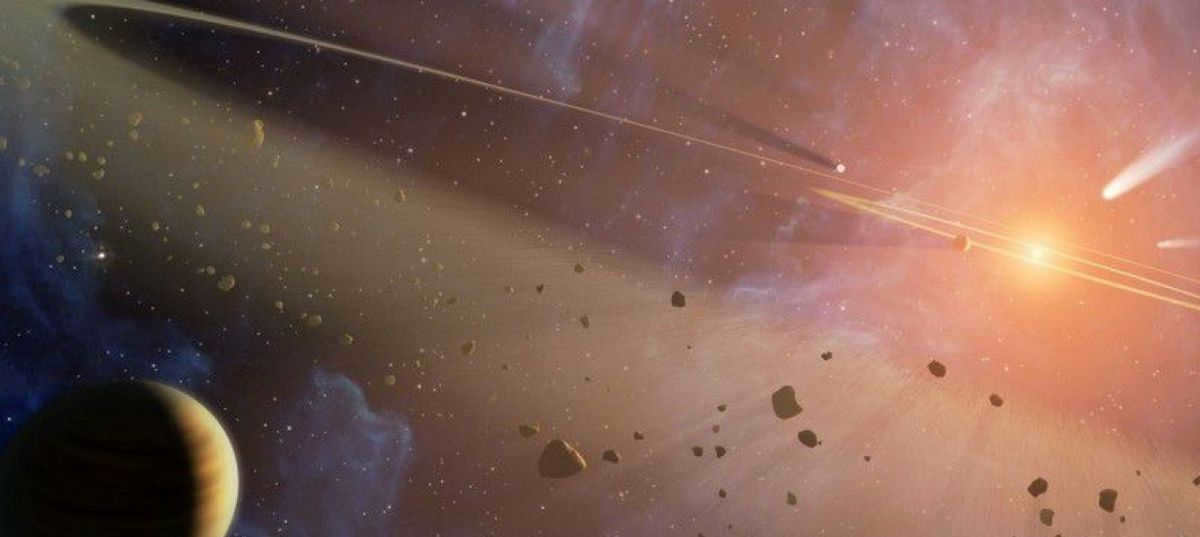
Most likely, many of you are familiar with the vast ring of rocks and other space debris located between Mars and Jupiter – this is known as the asteroid belt. There are some individuals who speculate that it is the remnants of a shattered planet. However, I am here to dispel that notion – it is not the case. Today, I will provide you with an explanation of what the asteroid belt truly is, how it came to be, when it was first discovered, and the fascinating objects that can be found within it. Please, make yourselves comfortable and join me on this journey.
Between Mars and Jupiter
The discussion about the asteroid belt began approximately two centuries ago. I will refrain from delving into its historical background as there is little noteworthy information available. Currently, the asteroid belt is recognized as one of the most substantial concentrations of celestial bodies (commonly referred to as debris) within our solar system. Therefore, what do we truly comprehend about this region and what fuels the widespread fascination surrounding it?
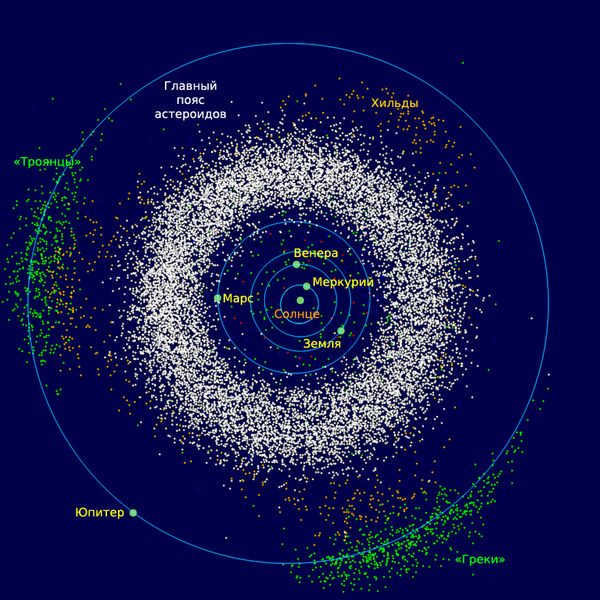
Overview
The asteroid belt, located between Mars and Jupiter, is home to over three hundred thousand asteroids. Among the largest are Ceres, Vesta, Pallada, and Hygeia, which are named after Roman gods, following the tradition of naming celestial bodies in our solar system. Ceres is even classified as a dwarf planet. However, the study of the asteroid belt is currently focused on scientific research, although its origins can be traced back to fairy tales and legends.
The enigmatic Phaeton
Did you ever dream of becoming a cosmonaut like Gagarin or Tereshkova when you were a child? Undoubtedly, many of us had such aspirations – to explore space, mysterious entities, distant galaxies, and uncharted worlds. Phaeton, a planet that once existed between Mars and Jupiter but met its demise, is also included in this list. It’s an enchanting tale, isn’t it?
If you are interested in reading captivating material about this “planet,” I highly recommend delving into the novel “Phaetons” by Alexander Kazantsev. It offers a truly engaging story about the planet’s inhabitants who, driven by their insatiable greed, ultimately led to its destruction.
Mathematics came to the aid in these contentious disputes, demonstrating that by aggregating all of these “pebbles” together, this small collection would be sufficient to form an object the size of the Moon, but insufficient for the creation of a fully-fledged planet.
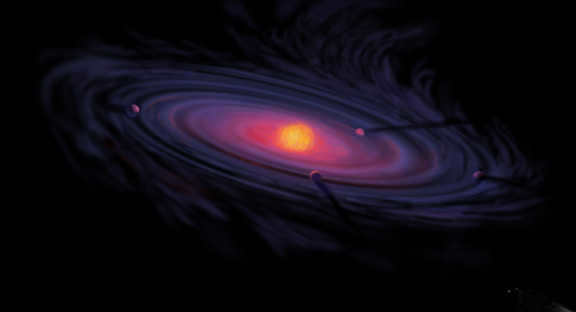
Nevertheless, the theories suggesting that Jupiter’s gravity tore apart a planet are partially accurate. While it is possible for such an event to occur, there is one crucial factor to consider: the planet would have needed to form in that location first. However, the powerful gravitational forces of Jupiter would have prevented this from happening. Therefore, it is more plausible to conclude that the celestial body attempted to form in the region, but was unable to do so, resulting in Jupiter effectively “crushing” all the protoplanetary matter beneath it. This brings our investigation to a close. Spread the word among your friends and acquaintances, so they too can be aware of this fascinating discovery. Nonetheless, I encourage you to verify the information yourself, as it is readily available to everyone.
Meteorite investigation
Up to the present time, thorough examination of meteorites that have been detached from the asteroid belt has revealed that the majority of them are chondrites, wherein there was no segregation of substances distinctive to the process of planet formation. This once again affirms the theory I expounded earlier. Science is not akin to Sumerian myths.
The asteroid belt is composed of protoplanetary matter that had been generated during the formation of the solar system. However, it is more captivating to put faith in Phaeton rather than to put faith in science – its knowledge.
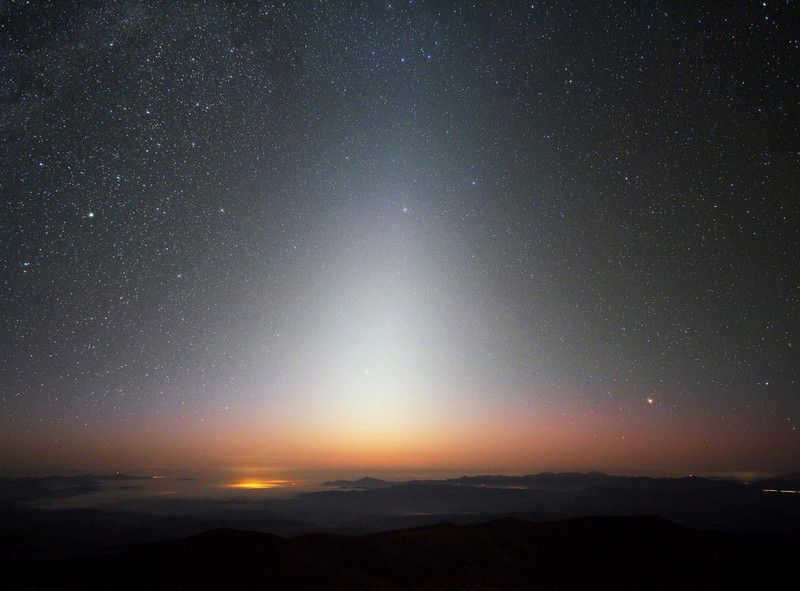
The asteroid belt: a result of the discovery
The theory of the existence of the planet Phaeton, although proven false, still had significant implications. Johann Titius, an 18th-century German physicist, devised a formula in his pursuit of uncovering this enigmatic planet. This formula, in turn, enabled the approximation of the locations of all the planets within the solar system. It was this formula that ultimately led to the discovery of Uranus 15 years later. Subsequently, the asteroid belt emerged as the primary candidate for the remnants of the destroyed planet Phaethon.
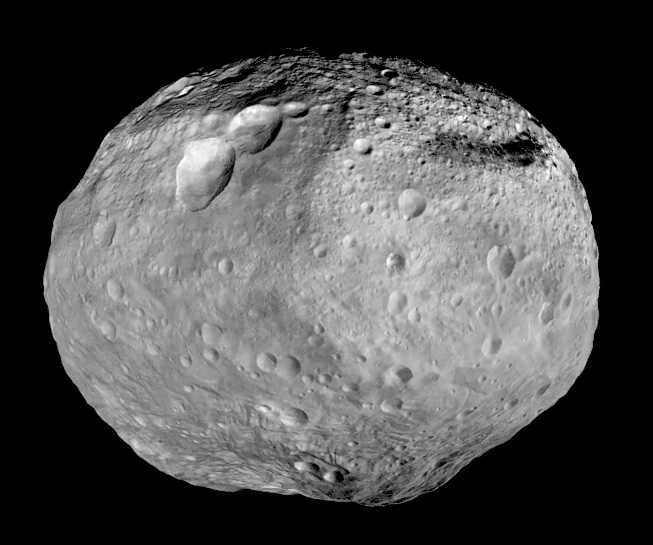
The Unveiling of Ceres
During the early 1800s, the largest celestial body in the asteroid belt was unveiled – Ceres. This momentous event occurred in 1801, and just a year later, Pallada, another sizable asteroid, was discovered. Three years subsequently, Juno came into view, followed by Vesta in 1807. All of these celestial objects traversed the same orbit around the Sun – 2.8 astronomical units (For reference, an astronomical unit equates to 149,598,000 km). The unveiling of these asteroids did not cease until 1891, when Max Wolf, a German astronomer, stumbled upon 248 smaller asteroids. And you might assume that this marked the culmination of such discoveries? Think again, for new unveilings continued to rain down like a cascade of chestnuts in the autumn. Presently, there are over 300,000 asteroids in existence, as I mentioned at the outset.
